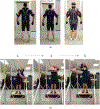Shoulder-assist exoskeleton effects on balance and muscle activity during a block-laying task on a simulated mast climber
- PMID: 39449710
- PMCID: PMC11497863
- DOI: 10.1016/j.ergon.2024.103652
Shoulder-assist exoskeleton effects on balance and muscle activity during a block-laying task on a simulated mast climber
Abstract
Interest in utilizing exoskeletons to mitigate the risks of musculoskeletal disorders (MSDs) among construction workers is growing, spurred by encouraging results in other industries. However, it is crucial to carefully examine their impact on workers' stability and balance before implementation. In this study, seven male participants lifted a 35-lb cinder block from a production table to a simulated wall at two heights-elbow and shoulder levels-using three different exoskeleton models on an unstable platform, where their balance and shoulder muscle activity were assessed. Balance-related parameters, included mean distance (MDIST), total excursion (EXCUR), and mean velocity (VEL) of the center of pressure, were derived from force plate data. Muscle activity in six shoulder and upper arm muscles was estimated using electromyography (EMG) data. The results indicated that wearing two of the exoskeletons significantly increased both total and medio-lateral (ML) MDIST compared to not wearing an exoskeleton. Wearing one of the exoskeletons significantly increased total and ML VEL and ML EXCUR. Although lifting level did not have a significant impact on the balance parameters, it did affect the muscle activity in most of the measured muscles. Moreover, only one exoskeleton significantly reduced the activity in a particular shoulder muscle compared to no exoskeleton use. In conclusion, the evaluated shoulder-assist exoskeletons showed limited benefits for preventing upper extremity MSDs and may negatively affect whole-body balance during a block-laying task on an unstable platform. These findings underscore the importance of comprehensive evaluations of balance and effectiveness prior to adopting exoskeletons in construction.
Keywords: Construction; Masonry worker; Mast climber; Musculoskeletal disorders; Postural instability; Shoulder-assist exoskeletons; Whole-body balance.
Figures





Similar articles
-
Model-Based Comparison of Passive and Active Assistance Designs in an Occupational Upper Limb Exoskeleton for Overhead Lifting.IISE Trans Occup Ergon Hum Factors. 2021 Jul-Dec;9(3-4):167-185. Epub 2021 Jul 26. IISE Trans Occup Ergon Hum Factors. 2021. PMID: 34254566 Free PMC article.
-
The Exo4Work shoulder exoskeleton effectively reduces muscle and joint loading during simulated occupational tasks above shoulder height.Appl Ergon. 2022 Sep;103:103800. doi: 10.1016/j.apergo.2022.103800. Epub 2022 May 19. Appl Ergon. 2022. PMID: 35598416
-
Influence of an upper limb exoskeleton on muscle activity during various construction and manufacturing tasks.Appl Ergon. 2024 Jan;114:104158. doi: 10.1016/j.apergo.2023.104158. Epub 2023 Oct 25. Appl Ergon. 2024. PMID: 37890312
-
Differential effect of three types of exoskeletons and handling height on muscular activity, postural control and perceived effort during simulated bedside mobilization task.Appl Ergon. 2025 May;125:104467. doi: 10.1016/j.apergo.2025.104467. Epub 2025 Jan 22. Appl Ergon. 2025. PMID: 39847850 Review.
-
Effect of exoskeleton devices on work-related musculoskeletal disorders (WMSDs) among healthcare workers: a scoping review.Ergonomics. 2024 Oct 13:1-13. doi: 10.1080/00140139.2024.2413150. Online ahead of print. Ergonomics. 2024. PMID: 39396223 Review.
Cited by
-
Adverse Effects Due to the Use of Upper Limbs Exoskeletons in the Work Environment: A Scoping Review.Biomimetics (Basel). 2025 May 21;10(5):340. doi: 10.3390/biomimetics10050340. Biomimetics (Basel). 2025. PMID: 40422170 Free PMC article. Review.
References
-
- Ahrnsbrak R, Bose J, Hedden S, Lipari R, Park-Lee E, 2017. Key Substance Use and Mental Health Indicators in the United States: Results from the 2016 National Survey on Drug Use and Health. HHS Publication, Rockville, MD.
-
- Anton D, Bray M, Hess JA, Weeks DL, Kincl LD, Vaughan A, 2020. Prevalence of work-related musculoskeletal pain in masonry apprentices. Ergonomics 63, 1194–1202. - PubMed
-
- Antwi-Afari MF, Li H, Chan AHS, Seo J, Anwer S, Mi H-Y, Wu Z, Wong AYL, 2023. A science mapping-based review of work-related musculoskeletal disorders among construction workers. J. Saf. Res 85, 114–128. - PubMed
-
- Armstrong TJ, Buckle P, Fine LJ, Hagberg M, Jonsson B, Kilbom A, Kuorinka IA, Silverstein BA, Sjogaard G, Viikari-Juntura ER, 1993. A conceptual model for work-related neck and upper-limb musculoskeletal disorders. Scand. J. Work. Environ. Health 19, 73–84. - PubMed
-
- Bär M, Steinhilber B, Rieger MA, Luger T, 2021. The influence of using exoskeletons during occupational tasks on acute physical stress and strain compared to no exoskeleton - a systematic review and meta-analysis. Appl. Ergon 94, 103385. - PubMed
Grants and funding
LinkOut - more resources
Full Text Sources
